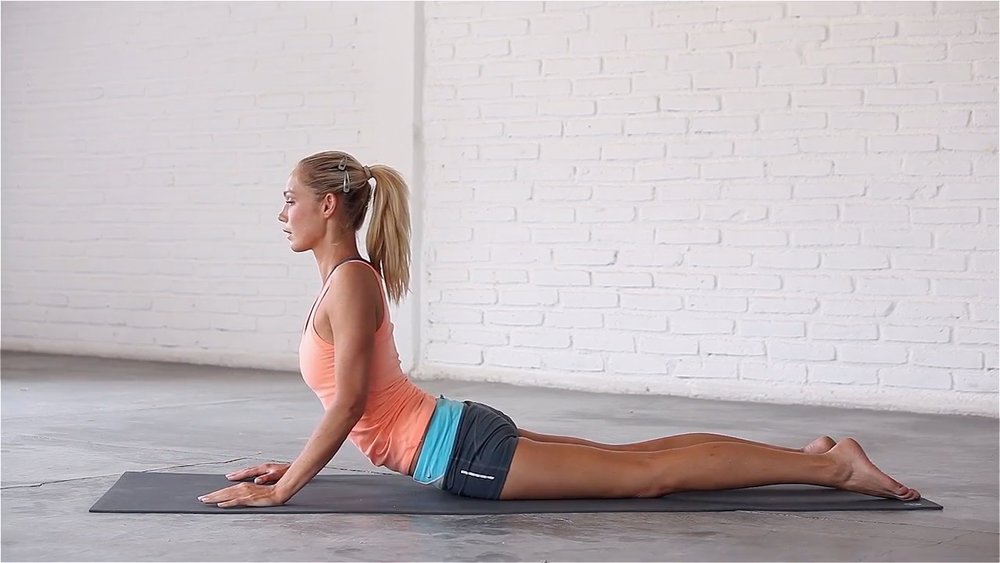How to streamline your practice and still reap the benefits of yoga.
By Abi Carver (Founder, Yoga 15)
What busy entrepreneur has time for a 90-minute yoga classes even just once a week? Don’t worry. You don’t have to. Did you know you can squeeze in a few minutes here and there and still get the same benefits as if you were attending several long classes a week?
And who better to give insight into an efficient and optimized workout routine than 4-hour mastermind Tim Ferriss?
Since the publication of The 4-Hour Workweek in 2007, the New York Times bestselling author continues to provoke readers to challenge assumptions, question popular beliefs and seek out unconventional ways to live a richer and more fulfilled life. The Ferriss approach involves deconstructing complex topics, and then demonstrating the simplest and most effective way to master them.
Can yoga, an ancient discipline characterized by surrendering and going with the flow, stand up to the same level of scrutiny?
Optimized Yoga
Yoga has been proven consistently in the research to have a great many benefits. Yoga can help you:
- Build strength
- Increase mobility
- Improve balance
- Relieve stress
- Improve sleep
- Boost mood
- Enhance cognitive performance
But you don’t often hear the words yoga and optimized, productive, methodical or systematic in the same breath. With more than 20 million practitioners in the United States, 82 percent of which are women, the time has come to hold yoga’s feet to the fire.
Here are seven ways to apply the principles Tim Ferriss teaches in the 4-Hour canon to establish your own consistent, effective and efficient home yoga practice.
1. Optimize Your Body
In an episode of his podcast, The Tim Ferriss Show, Ferriss uses the metaphor of a racing car to explain why the physical body is the focus of so much of his work:
“The car itself, the vehicle, is the physical body upon which everything is predicated. People tend to have this Cartesian separation of mind and body. But at the end of the day you have certain levels of neurotransmitters that are produced at a certain rate, depleted at a certain rate, and that is the rate-limiting step in your mental performance. So if you want to have better levels of working memory, sustained attention and so on, you can optimize those by optimizing the car, i.e. the body. You can use exercise to improve the production of Brain Derived Neurotrophic Growth Factor and all these things that are very very interesting.”
Yoga is a great tool, as part of a well-formulated training program, for improving health in both body and mind. With consistent practice, you’ll increase your strength, suppleness, range of motion, stamina, endurance, power, agility, balance, body awareness, breath efficiency, physical fitness and coordination, which ultimately enhances focus, concentration, calm and clarity.
2. “Everything Popular is Wrong” — Oscar Wilde
“Whenever you find yourself on the side of the majority, it’s time to pause and reflect.” — Mark Twain
When facing a problem or tackling a new skill, Ferriss poses the following questions:
- What are the untested assumptions?
- What do we all believe is true?
- What if the opposite were true?
Yoga, as adopted by the West, is rife with untested assumptions and unsubstantiated beliefs. There are many aspects of the practice that you may find hard to swallow. The classes are typically incredibly long and intentionally lack structure, consistency and a clear progression. Also, for many the imported spirituality does not resonate. The benefits in terms of enhancing physical and mental performance are well-supported by the research but it can be a struggle to find an efficient, effective, optimized yoga method to sign up for.
When you feel tight, tense or irritable and you are unable to attend a full length yoga class, look online for short sessions that have a clear objective, eg. to increase core strength. Due to the recent explosion of short, digital yoga classes available on apps, websites, YouTube and on demand TV, there are lots of options to choose from in countless different styles.
3. Minimum Effective Dose
“The minimum effective dose (MED) is defined simply: the smallest dose that will produce a desired outcome…Anything beyond the MED is wasteful.” — Tim Ferriss, The 4-Hour Body
“Perfection is achieved, not when there is nothing more to add but when there is nothing left to take away.” — Antoine de Saint-Exupéry
Yoga classes typically last 60-90 minutes, which is a major barrier to entry for busy, productive people, leading demanding, high-pressure lifestyles. If you deconstruct the class into discrete skills, you can reduce the length of each workout. The minimum possible length for a session, allowing for warm-up, working out and cooling down, is around 15 minutes. This is the MED.
Practicing a different objective, such as hip mobility, core strength, breath efficiency, mental focus or stress relief, each day for 15-20 minutes has the advantage of being not only more effective from a physiological perspective, but also much easier to stick to than committing to a long, expensive, weekly class in another neighborhood.
Again, to quote Tim Ferriss: “The decent method you follow is better than the perfect method you quit.”
4. 80/20 Principle
The “80/20 Principle” or “Pareto’s Law” first appears in The 4-Hour Workweek and is a recurring theme throughout all of Ferriss’ work.
The “80/20 Principle” states that 80 percent of outputs come from 20 percent of inputs. By identifying the correct inputs, you can achieve the greatest results with the smallest amount of effort.
Tim Ferriss applies this principle to language learning: “To be perceived as fluent in conversational Spanish…you need an active vocabulary of approximately 2,500 high-frequency words [out of] the estimated 100,000 words in the Spanish language.”
The inference being that you only need to learn 20 percent of the language to achieve 80 percent fluency.
Due to the current ubiquity of short, online yoga sessions, you can achieve a high level of yoga mastery and gain the majority of the benefits from the practice at a fraction of the cost, in only 15-20 minutes a day, without having to go to a studio or commit to a membership.
5. Habit Formation
“We break commitments to ourselves with embarrassing regularity.” — Tim Ferriss, The 4-Hour Body
Habit formation or “engineering compliance” is a prevailing theme throughout Ferriss’ work. Here are a few of his recommendations:
Routines
Ferriss teaches his readers that routines and systems are more effective when trying to create a new habit than relying solely on self-discipline, which he believes is overrated. By establishing routines, your actions become automatic. You won’t have to dip into your limited supply of willpower every time you are faced with a decision.
“Don’t strive for variation — and thus increase option consideration — when it’s not needed. Routine enables innovation where it’s most valuable,” he suggests.
The beauty of short, goal-orientated yoga workouts is that you can fit them into your current routine without having to make any radical changes to your schedule.
Track or you will fail
“What gets measured gets managed.” — Peter Drucker
Initially, track everything. Record workouts completed, how you feel, improvements in flexibility, strength and range of motion, changes in mood, especially in high-stress situations and your ability to hold difficult poses. Track everything that is related to your yoga practice.
There are two distinct reasons for this. First, tracking progress brings awareness to your new habit, creating a positive feedback loop that is profoundly motivating. Second, by running a series of mini experiments on yourself, you can clarify your objectives, identify exactly what is and is not working and determine which teachers or schools deliver the most consistent results.
6. Early Wins
“You need immediate results that compel you to continue.” — Tim Ferriss, The Choice-Minimal Lifestyle
Ferriss asserts that early wins are critical for creating habit momentum. As a high performer and entrepreneur, you demand a great deal from your body and mind. Your work requires that you are predominantly sedentary and the pressure you subject yourselves to is unrelenting!
Practicing yoga feels amazing as it offers immediate relief from pain, stiffness and life stress. This generates a positive feedback loop, which makes it easier to stay committed to a consistent yoga habit. You can increase the impact of this effect by being mindful of how you feel after each yoga workout, giving yourself a moment to let the feeling really sink in.
7. Renewal Breaks
Ferriss introduces the idea of creating a daily architecture that includes renewal breaks in his interview with Joshua Waitzkin. This technique allows you to switch from conscious to unconscious thinking, in order to stoke creativity and accelerate productivity. This is where yoga can really move the needle for elite performers.
Ferriss recommends you ask yourself a question or assign your brain a problem to work on and then release your mind by engaging in a completely different task, such as exercise, sleep or meditation. Short yoga sessions during your work day are also particularly effective for this.
Yoga can be a form of moving meditation that is particularly suitable for people who find it hard to sit still and pay attention to their breath for more than a few seconds at a time! After focussing all your attention on your short yoga workout, return to the problem, before allowing in any other inputs (like checking email or Facebook) and wait for mind-blowing creative insights to arise in your consciousness.
With the recent boom in short, online classes that is now available to all of us, yoga is now accessible even to those of us with days packed to bursting with meetings, appointments, travel and family commitments. Try to give yourself permission to squeeze in a short session every couple of days and watch the calming effect ripple out into all areas of your life.
About the guest blogger: Abi Carver is the founder of Yoga 15, an iPhone app with 120 yoga videos that are 15-minutes long, skills-based and follow a clear progression. There are workouts for building strength, increasing flexibility, improving balance, alleviating pain, relieving stress and boosting cognitive performance. The app is free to download at www.yoga15.com.

